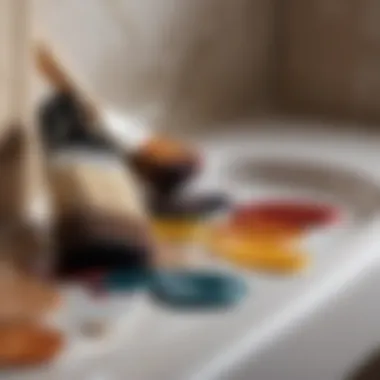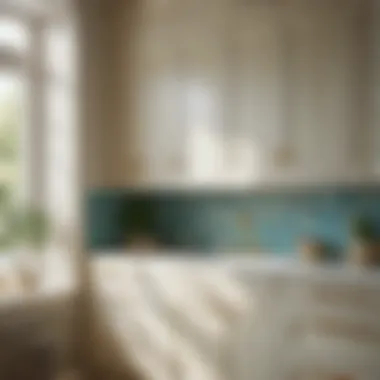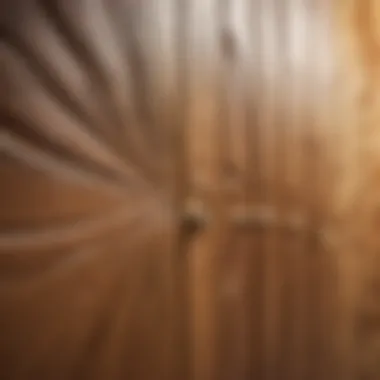Crafting Exquisite Bathroom Cupboards: A Masterclass in Painting Techniques


Materials:
- Primer: 1 gallon
- Paint: 2 gallons
- Sandpaper: 1 pack of 120-grit and 1 pack of 220-grit
- Painter's tape: 3 rolls
- Drop cloths: 2 large
- Paintbrushes: 2 assorted sizes
- Roller and tray: 1 set
DIY Steps:
- Preparation:
- Priming:
- Painting:
- Finishing Touches:
- Remove all hardware from the cupboards.
- Clean the surfaces thoroughly with a mild detergent.
- Sand the cupboards to create a smooth base for painting.
- Apply a coat of primer evenly on all surfaces.
- Allow the primer to dry completely before proceeding.
- Use painter's tape to protect areas you don't want to paint.
- Start painting with a brush for edges and corners, then switch to a roller for larger surfaces.
- Apply multiple thin coats for a professional finish.
- Let the final coat dry for at least 24 hours.
- Reattach hardware once the paint is fully cured.
- Clean up any drips or spills for a polished look.
Technical Aspects:
- Tools: Sandpaper, paintbrushes, roller, painter's tape
- Timing: Allow 2-3 days for the entire painting process
- Techniques: Proper sanding for a smooth finish, even paint application
DIY Project Process:
- Start by gathering all materials and organizing your workspace.
- Follow the step-by-step guide for preparation, priming, painting, and finishing.
- Pay attention to detail and take your time for the best results.
- Troubleshooting Tips:
- If paint drips occur, sand lightly and repaint the affected area.
- In case of uneven coverage, apply an extra coat for consistency.


Introduction
Specific Elements
Painting bathroom cupboards involves more than just adding a fresh coat of paint. It requires a meticulous approach, starting from selecting the right paint type suitable for the environment in terms of humidity and frequent use. Beyond paint selection, factors such as color palette, preparation methods, and finishing techniques are crucial to ensure a professional and durable result.
Benefits
The benefits of painting bathroom cupboards extend beyond visual enhancement. By refreshing the appearance of these essential storage units, you have the opportunity to update the overall look and feel of your bathroom without undertaking a complete renovation. Additionally, repainting cupboards allows for customization, enabling you to match them with the existing decor theme or introduce a contrasting accent for a unique touch.
Considerations
Before embarking on the painting journey, understanding the intricacies of the process is essential. Factors such as proper surface preparation, choice of suitable supplies, and adherence to painting techniques are critical considerations that can impact the final outcome. Moreover, taking into account the specific requirements of bathroom environments, including moisture resistance and durability, is crucial for ensuring longevity and quality in the painted finish.
Understanding the Basics of Painting Bathroom Cupboards
In this article, we dive deep into the crucial foundation of painting bathroom cupboards, showcasing its significance in transforming the aesthetics of your space. Understanding the basics is essential as it sets the groundwork for a successful and visually appealing outcome. From selecting the right paint to choosing the ideal color palette and gathering the necessary supplies, each aspect plays a key role in the overall process.
Selecting the Right Paint
When it comes to painting bathroom cupboards, selecting the right paint is paramount. Opting for high-quality paint specifically designed for cabinets and bathroom environments ensures durability and longevity. Consider factors such as moisture resistance, ease of application, and finish options. Water-based enamel paints are a popular choice for their easy cleanup and excellent adhesion to cabinet surfaces. Be sure to choose a paint color that complements your existing decor and enhances the overall aesthetic of your bathroom.
Choosing the Color Palette
The color palette you choose for your bathroom cupboards can significantly impact the ambiance and visual appeal of the space. Whether you prefer a classic white for a bright and timeless look or a bold hue for a statement piece, selecting the right colors is crucial. Neutral tones like greys, beiges, and soft blues are versatile choices that can complement a variety of decor styles. Alternatively, opting for a pop of color can add personality and interest to your bathroom. Consider the overall color scheme of your bathroom when choosing a palette to ensure cohesiveness and harmony in the design.


Gathering the Necessary Supplies
Before embarking on the painting journey, it is essential to gather all the necessary supplies to ensure a smooth and efficient process. Essential supplies include painter's tape for masking off areas, sandpaper for smoothing surfaces, a paintbrush or roller for application, primer for preparing the surface, and the selected paint color. Additionally, cleaning supplies such as soap and water or a mild degreaser are needed to clean the cupboards thoroughly before painting. Having all the supplies on hand before starting the project will help streamline the painting process and achieve professional results.
Preparation Phase
The preparation phase is a critical component of the entire process when aiming to paint bathroom cupboards. Proper preparation ensures the success and longevity of the paint job, making it essential to pay close attention to this stage. Cleaning and sanding the cupboards are the initial steps that set the foundation for a smooth and professional finish.
Cleaning and Sanding the Cupboards
Cleaning the cupboards is not just about removing surface dirt; it involves a thorough cleansing to eliminate any grime, grease, or residues that can affect the adhesion of the paint. Use a mild detergent or cleaning solution to scrub the surfaces and ensure they are completely clean and dry before proceeding.
Sanding the cupboards is equally important as it helps in achieving a smooth and even surface for the paint to adhere to. Use sandpaper of the appropriate grit to gently scuff the surface, removing any existing finish or imperfections. This step enhances the bond between the paint and the surface, promoting a flawless final result.
Removing Hardware and Masking Off Areas
Before painting, it is crucial to remove all hardware such as handles, knobs, and hinges from the cupboards. This step allows for easier access and ensures a more uniform paint application. Additionally, masking off areas like hinges, door edges, and surrounding walls with painter's tape prevents accidental paint splatter and facilitates a cleaner finish.
Strategic preparation is the key to achieving professional-looking painted bathroom cupboards. By meticulously cleaning, sanding, removing hardware, and masking off areas, you set the stage for a successful painting process and superior end result.
Painting Process
Priming the Cupboards
Before diving into the exciting realm of color and style, priming the cupboards sets the foundation for a successful paint job. Priming not only enhances adhesion but also improves the durability and longevity of the paint. This step ensures a smooth and even application of the topcoat, preventing any imperfections or discoloration from seeping through. Opting for a high-quality primer specifically designed for bathroom surfaces is vital to achieve optimal results. Take your time during this phase, as proper priming sets the stage for a professional finish that will last for years to come.


Applying the Paint Coats
Once the cupboards are primed and ready, it's time to unleash your creativity with the application of paint coats. Choosing the right paint type and color is essential in achieving the desired aesthetic for your space. Whether opting for a striking bold hue or a subtle neutral tone, each coat should be applied evenly and methodically. Avoid rushing through this process, as multiple thin coats yield better results than one thick layer. Allow ample drying time between each coat to ensure proper adhesion and a seamless finish. By taking your time and applying the paint coats meticulously, you will create a visual masterpiece that enhances the overall ambiance of your bathroom.
Techniques for a Smooth Finish
To elevate your painting game and achieve a smooth finish reminiscent of professional craftsmanship, mastering the right techniques is key. Embracing methods such as brush strokes in the direction of the wood grain, using high-quality brushes or rollers, and maintaining a consistent pressure throughout the application process will result in a flawless finish. Additionally, implementing techniques like feathering edges and blending the paint seamlessly at the corners and edges will elevate the aesthetics of your cupboards. Remember, patience and precision are your allies in achieving a smooth finish that exudes sophistication and style.
Finishing Touches
In the realm of painting bathroom cupboards, the finishing touches serve as the final punctuation mark, elevating the entire project to a new level of finesse and sophistication. These last details are what differentiate a haphazard paint job from a professional-looking finish that exudes charm and durability. When it comes to the finishing touches, there are specific elements that must be considered to ensure the longevity and visual appeal of the painted surface.
One crucial aspect of finishing touches is sealing and protecting the painted surface. This step not only enhances the overall look of the cupboards but also shields them from everyday wear and tear, such as moisture exposure and accidental scratches. By applying a high-quality sealant, you can prolong the life of your paint job and keep the cupboards looking fresh and vibrant for years to come. Choosing the right sealant that is compatible with the type of paint used is essential for achieving optimal results.
Reattaching hardware and conducting a final inspection are equally important facets of the finishing touches phase. Reinstalling the cupboard hardware in a meticulous manner ensures that the functionality of the cupboards is restored, allowing for seamless usage. Moreover, a final inspection allows you to identify any imperfections or missed spots that may require touching up. This thorough examination guarantees that the end result meets your expectations and standards of quality.
Embracing the final stages of painting bathroom cupboards with diligence and attention to detail is key to achieving a polished and professional outcome. By focusing on sealing and protecting the painted surface, as well as reattaching hardware and conducting a meticulous final inspection, you can ensure that your cupboards not only look exquisite but also stand the test of time.
Maintenance Tips for Painted Cupboards
Maintaining your painted cupboards is vital to preserving their beauty and ensuring longevity. Following proper maintenance tips can extend the lifespan of your painted cupboards and keep them looking fresh. Here are some essential maintenance tips for painted cupboards:
- Regular Cleaning: Dust and stains can accumulate on painted surfaces over time. It's important to regularly wipe down your cupboards with a soft cloth or microfiber towel to remove dust and debris. Avoid using harsh chemicals that can damage the paint.
- Avoid Moisture Exposure: Moisture can be detrimental to painted surfaces, causing paint to peel or bubble. Make sure to keep your bathroom well-ventilated to prevent moisture buildup. Wipe up any spills or splashes immediately to prevent water damage.
- Use Gentle Cleaning Agents: When cleaning painted cupboards, opt for mild cleaning agents such as dish soap diluted in water. Harsh chemicals and abrasive cleaners can strip the paint or cause discoloration. Test any new cleaner on a small, inconspicuous area before using it on the entire surface.
- Touch-Ups: Over time, painted cupboards may experience wear and tear, such as minor scratches or chips. Keeping a small amount of touch-up paint on hand can help you quickly address any imperfections. Touch up any blemishes as soon as they occur to prevent further damage.
- Inspect Hardware Regularly: The hardware on your cupboards, such as handles and knobs, can loosen or corrode over time. Regularly inspect and tighten any loose hardware to prevent damage to the painted surface. Consider replacing any hardware that shows signs of wear.
By incorporating these maintenance tips into your routine, you can ensure that your painted cupboards retain their beauty and durability for years to come. Proper maintenance not only enhances the aesthetics of your bathroom but also protects your investment in painting them.
Conclusion
The Conclusion section encapsulates the essence of the painting endeavor, highlighting the attention to detail and effort required to achieve a flawless outcome. It underlines the importance of patience and precision in each step of the process, ensuring the durability and aesthetic appeal of the painted cupboards for years to come.
Moreover, the Conclusion offers insights into the long-term benefits of properly painted bathroom cupboards, such as enhancing the overall decor of the space, adding value to the home, and showcasing the owner's unique style and personality. By following the comprehensive guide provided throughout the article, readers can embrace the creative journey of transforming mundane cupboards into focal points of admiration within their homes.







